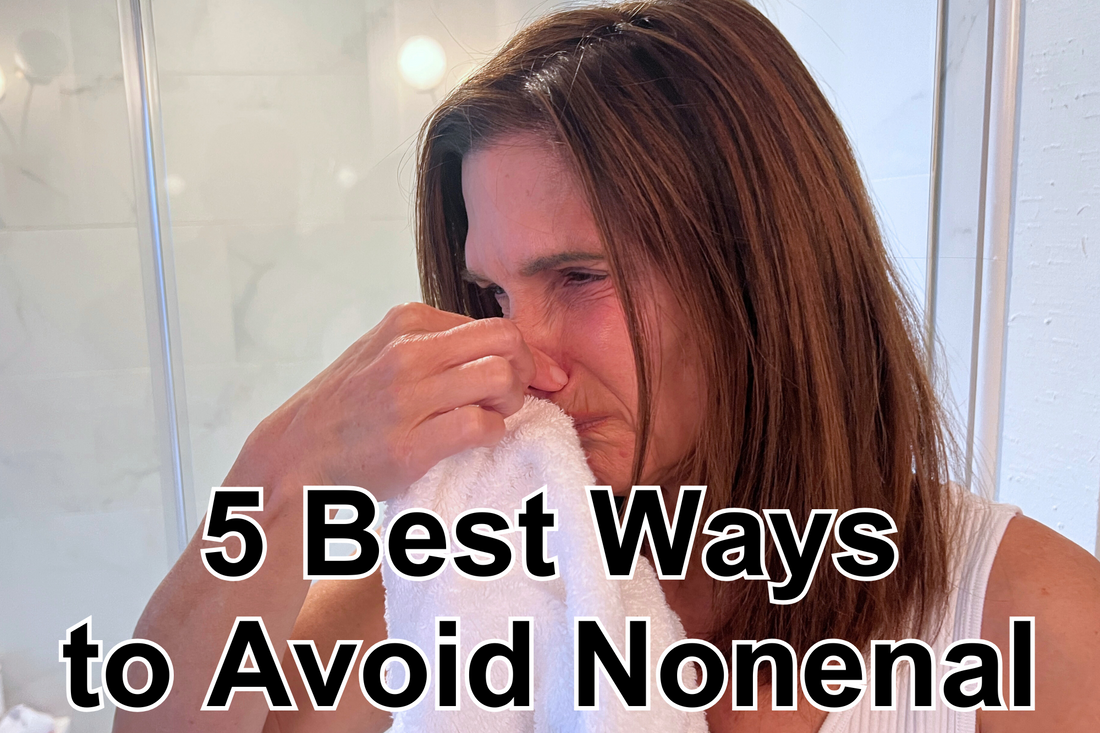
5 Best Ways to Avoid Nonenal: The Hidden Cause of Aging Odor
Share
What Is Nonenal?

Aging brings many changes, including a shift in body odor that can be difficult to manage. This distinct smell, often associated with seniors, is caused by Nonenal odor, a compound produced by the breakdown of fatty acids in the skin. Unlike typical body odor, Nonenal is waxy, hydrophobic (afraid of water), and lingers on clothes and skin despite regular washing.
At What Age Does Nonenal Start to Develop?

Nonenal™ typically begins to appear around the age of 40. As the body undergoes hormonal changes, it produces fewer antioxidants that neutralize oxidative stress on the skin. This leads to an increase in unsaturated fatty acids, which react with air and produce Nonenal. While Nonenal odor is most noticeable in individuals over 50, some people experience it earlier due to genetics, diet, or lifestyle.
The Challenges of Dealing With Nonenal Odor
Many people remain unaware of Nonenal odor until someone else notices it. Since it is oil-based, it sticks to fabrics, bedding, and even furniture. Traditional soaps and deodorants fail to remove it effectively, leading to frustration for those struggling to control their scent. If left unmanaged, it can affect confidence, social interactions, and overall well-being.
What Causes Nonenal Odor?

Several factors contribute to the development of Nonenal odor, including:
Oxidation of Skin Lipids – As we age, the skin secretes more unsaturated fatty acids, which react with air and produce Nonenal.
Hormonal Changes – A drop in estrogen and testosterone levels increases oxidative stress, contributing to Nonenal formation.
Diet and Lifestyle – High-fat diets, alcohol consumption, and smoking accelerate skin oxidation, worsening the odor.
Poor Hygiene Practices – While regular bathing is essential, using the wrong products may allow Nonenal to persist.
Clothing and Bedding Residue – Nonenal binds to fabrics, making it difficult to eliminate through normal washing routines.
Why Regular Soaps Fail to Remove Nonenal
Most commercial soaps are designed to remove water-based body odor caused by sweat and bacteria. However, Nonenal is oil-based, which means that traditional body washes and soaps fail to break it down effectively. Even antibacterial soaps do not address the root cause, leaving the odor behind and making daily hygiene frustrating.

The Science Behind Nonenal and How to Effectively Eliminate It
The key to removing Nonenal odor lies in using ingredients that can break down its oil-based nature.
Effective Solutions Include:
Persimmon Extract – Contains powerful antioxidants that help neutralize Nonenal and break down its compounds.
pH-Balanced Soaps – Reduce excess skin oxidation while gently cleansing without stripping natural oils.
Deep Cleansing Products – Designed to target aging odor and remove oil-based residues from skin and clothing.
A clinically proven solution is Mirai Clinical Deodorizing Soap with Persimmon, which is specifically formulated to dissolve Nonenal effectively and keep you fresh all day. Unlike regular soaps, Mirai Clinical soap is designed to eliminate the root cause of Nonenal odor, rather than just masking it.
5 Best Ways to Prevent and Control Nonenal Odor Naturally

Eliminating Nonenal odor requires a combination of skincare, lifestyle changes, and proper hygiene. Here are five effective ways to control and prevent it naturally:
1. Use a Specialized Soap
Switch to a soap with persimmon extract, known for its ability to neutralize Nonenal odor. Unlike regular soaps, it actively targets the root cause and removes aging-related body odor.
📢 Try Mirai Clinical Soap Today Order Now
2. Wash Clothes and Bedding Thoroughly
Nonenal lingers on fabrics, so washing clothes with baking soda or vinegar helps break down its oily residue. Consider using enzyme-based detergents for better results.
3. Maintain a Healthy Diet
Reduce consumption of fatty foods and processed items. Eat more antioxidant-rich foods like green tea, leafy greens, and citrus fruits to combat oxidative stress and support skin health, especially with these top foods for healthy skin after 40.
4. Hydration and Regular Exfoliation
Drinking plenty of water and exfoliating regularly helps flush out toxins and dead skin cells that contribute to Nonenal buildup.
5. Wear Breathable Fabrics
Synthetic fabrics can trap odors, while natural fibers like cotton and linen allow better air circulation and minimize odor retention. You can explore more tips on the best clothing choices for old peoples in our detailed guide.
Can You Smell Nonenal on Yourself?
 One of the most challenging aspects of Nonenal odor is that you may not notice it on yourself. Since our noses adapt to familiar scents, many people remain unaware of the subtle changes in their body odor as they age. If a loved one mentions a change in your scent or you notice that clothes retain an odor even after washing, it may be time to take action. To understand more about the reasons behind these changes, check out our detailed article on Why Body Odor Changes After 40.
One of the most challenging aspects of Nonenal odor is that you may not notice it on yourself. Since our noses adapt to familiar scents, many people remain unaware of the subtle changes in their body odor as they age. If a loved one mentions a change in your scent or you notice that clothes retain an odor even after washing, it may be time to take action. To understand more about the reasons behind these changes, check out our detailed article on Why Body Odor Changes After 40.
The best way to combat aging odor is by switching to a specialized soap like Mirai Clinical, which is uniquely formulated with persimmon extract to dissolve and eliminate Nonenal™. By adopting the right skincare routine and lifestyle habits, you can confidently maintain a pleasant and youthful scent.
